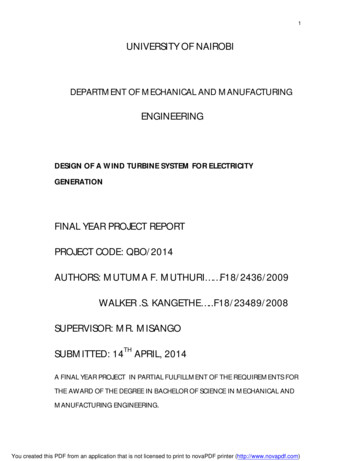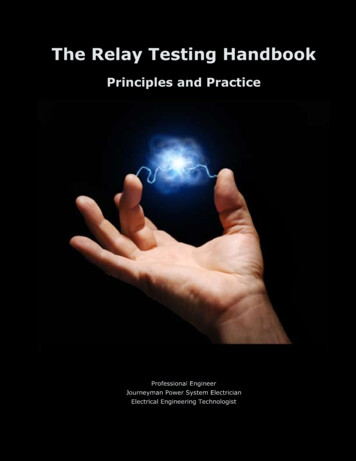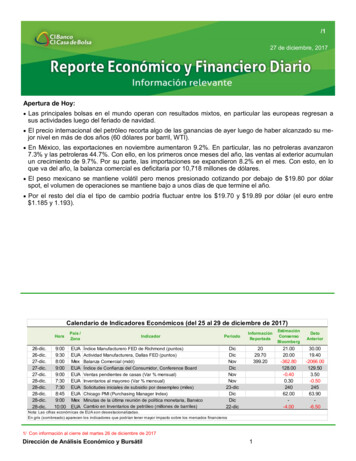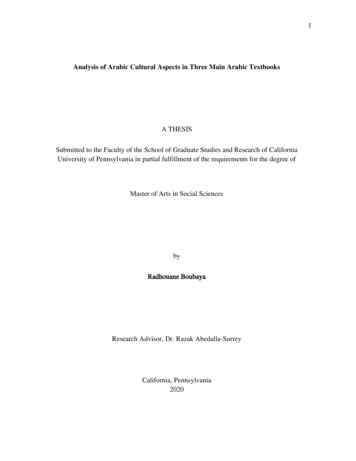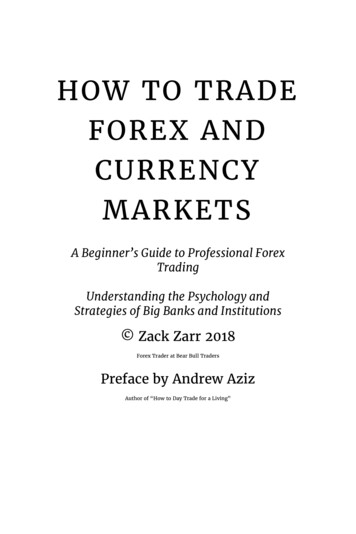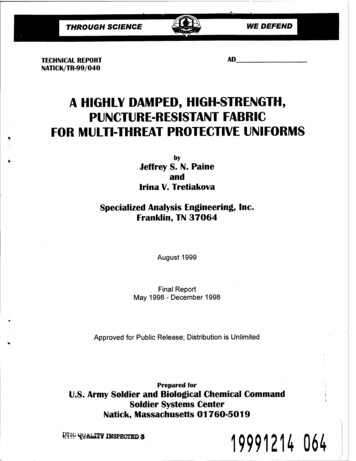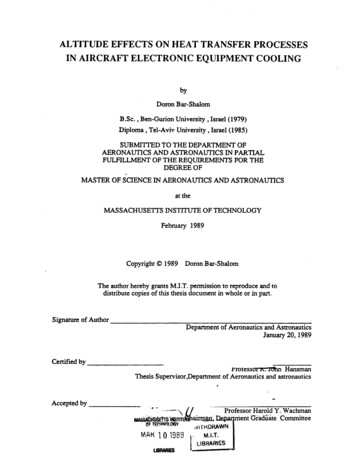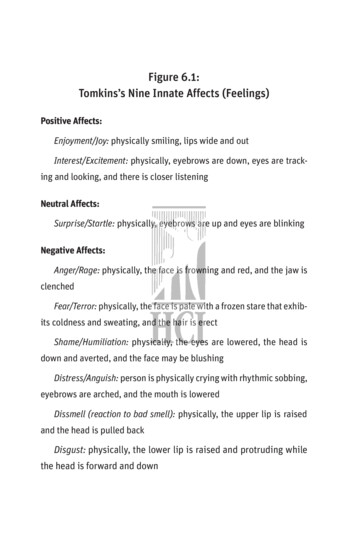
Transcription
106Part II: The “Work” of Abiding Love: Building Your Attachment ProgramFigure 6.1:Tomkins’s Nine Innate Affects (Feelings)Positive Affects:Enjoyment/Joy: physically smiling, lips wide and outInterest/Excitement: physically, eyebrows are down, eyes are tracking and looking, and there is closer listeningNeutral Affects:Surprise/Startle: physically, eyebrows are up and eyes are blinkingNegative Affects:Anger/Rage: physically, the face is frowning and red, and the jaw isclenchedFear/Terror: physically, the face is pale with a frozen stare that exhibits coldness and sweating, and the hair is erectShame/Humiliation: physically, the eyes are lowered, the head isdown and averted, and the face may be blushingDistress/Anguish: person is physically crying with rhythmic sobbing,eyebrows are arched, and the mouth is loweredDissmell (reaction to bad smell): physically, the upper lip is raisedand the head is pulled backDisgust: physically, the lower lip is raised and protruding whilethe head is forward and down
110Part II: The “Work” of Abiding Love: Building Your Attachment Programhuman is foreign to me,” Rogers felt he was adequate. He wasnot perfect because, as he says, “If we were perfect, we wouldnot be human. Perfect would not be enough.” We may be able toget a perfect score on an exam created by another human being,but we can never be perfect in our very being. Why? Becauseas human beings we are, as we say at The Meadows treatmentcenter, “perfectly imperfect.”One of our innate affects is shame, which is the maker ofour finitude. We are the animals who blush, because we arethe animals who can and will make mistakes. We make a hugemistake when we try to be more than human, that is, when wetry to act shameless and be perfect. Chart 7A is an adaptationfrom my book Bradshaw On: Healing the Shame that BindsYou (revised edition, p. 27).Chart 7A:Dynamics of the Affect ShameShamelessShameShamelessLess Than Human“Neurotic”An Innate Affect ThatMarks Our Finitudeand Forms our Senseof Self.More Than Human“Character Disordered”Just HumanWholly Imperfect“Perfectly Imperfect”PerfectTo Blame forEverythingSelf-ResponsibleNot to Blame for AnyMess-ups
Realistic ExpectationsLetting Go of Control111Balance Between Holding On &Letting GoHolding On—Trying To Stay InControl All The TimePower Thru VirtueSerenity Prayer*A False Sense ofPOWERConfessing Defectswith Little or oundariesInvulnerable RigidBoundariesUnderfunctioningCuriositasKnows Nothing“I am a Mistake.”Fully Functional SelfDocilityStill LearningMistakes Are MyTeachers.Over-FunctioningPridefulKnow It AllNo MistakesAnger As RageAnger As BoundaryPassive AggressiveAngerTo Blame forEverythingResponsible for Selfand BehaviorsNever To Blame forAnythingCompulsive:Moderation avingTemperanceAlcohol/DrugsTotally Flawed& DefectiveGod As I Understand—Humble, Being NobodySpecialAuthoritarian GodPower ThroughFailureA SinnerResigned to DamnationElitistKnow I’m Saved*AA uses the Serenity Prayer—“God grant me the serenity to accept the thingsI cannot change, help me to change the things I can and give me the wisdom toknow the difference.” It is believed that the theologian Reinhold Niebuhr firstsaid this.
118Part II: The “Work” of Abiding Love: Building Your Attachment ProgramIndependence as the Gateway to Interdependency,” involves thefull discovery of each partner’s feelings of true selfhood. It isthe world of “me and mine.” Stage 3, “The Realm of ‘Ours’:Interdependence” is the discovery of the true world of “ours,”the world of connection, commitment, and deep intimacy.Chart 7B: Six Fundamental ProblemsInherent in All Relationships1. The Difference Between Being:In-love (attraction and infatuation) and in-love and lustLove (secure attachment, attunement, caring connection,presence, and intimacy), understanding love as energetic workinvolving stages of commitment and maturation2. Differences1. Gender2. Temperament, tastes, idiosyncrasies, values, and needs3. High-T (testosterone) and low-T people4. Discrepancies in sexual desires5. Family rules—overt and coverta. Ethnicityb. Religionc. Moneyd. Parentinge. Householder—how the house should be keptf. Vocational
Realistic Expectations119g. Sexualh. Educationali. Celebrational—how to celebrate birthday, holidays, etc.j. Political3. Nonpathological and Pathological Wounds1. The normal biased world2. Attachment trauma3. Abuse and neglect4. Developmental dependency need deficits4. Degree of Solid Selfhood1. Ego strength and “true self” actualization2. Internal and external differentiation3. Developing semipermeable boundaries4. Level of emotional literacyCommunication Issues5. 6. Familiarity (the Frozen Image) and Fate1. The terrible “dailiness”2. Projection3. Disaster (misfortune)4. Betrayal5. FamiliarityWe’ve already dealt with number 1, the false beliefs surrounding our understanding of the romance program. Mostresearchers see being in-love as a nonworking prelude to love, notlove itself. I’ve discussed how the “love molecule” dramatically
Realistic ExpectationsChart 7C:121
134Part II: The “Work” of Abiding Love: Building Your Attachment Programterms, when one or both partners in a marriage have DDDs,their marriage will be “immature.”Look at Chart 8A.Chart 8A:In this family, Mom and Dad are getting their needs metthrough their own resources, and through their loving relationship with each other. The parental relationship is the chiefcomponent in the family. Mom and Dad are in the process ofbeing up-to-date with the developmental dependency needs oftheir inner child (i.e., they have grieved the loss of their earliest developmental dependency needs and are in the process ofmaking them fully conscious and learning how to repair them).
Growing Up: Exorcising Your “Hauntings”137Chart 8B:need a life apart from their children, a life that will hopefullybe growing after the children have grown up and left home. InHope Springs, Arnold and Kay failed to build their relationshipso that when their children grew up and left home, they hadnothing going for their lives. They were like two ships passingin the night. I think that it is almost “sacred” for Mom and Dadto have a night out every week, or as often as they can afford
140Part II: The “Work” of Abiding Love: Building Your Attachment ProgramChart 8C:Dad from dealing with the issues he has with his wife. Basically,his neglected inner child thought that his wife would motherhim in a way that his own mother never did.His wife has made her middle son (her oldest boy) her surrogate spouse. The son is quite a star in baseball and football,and is the salutatorian in his class. Mom confides in this son,sucking him into her marital problems (including how disgusting sex is with his father).
154Part II: The “Work” of Abiding Love: Building Your Attachment Programrecipient can only view the partner as a grave threat, set updefenses, stop listening, and ultimately withdraw emotionally,and, if possible, physically.Chart 9A: Self-Generating Cyclesof Negativity that Destroy RelationshipsThe Four Horsemen:Criticism: Judgment of partner’s behavior as badContempt: Judgment of partner’s very being as badDefensiveness: Loss of listening, contact, and empathyWithdrawal and Distance: Stonewalling, pouting, refusing tospeak, and separatingAs couples move down the stairs of degeneration, both partners begin to form an absolutized negative image of their marriage. Each feels like their spouse is the offender and that theyare the victim. (I am a huge fan of Gottman and his wife, Dr.Julie Schwartz Gottman, and I recommend all of their work. Itake full responsibility for any misinterpretation of the conclusions they have reached.)The Seven Deadly D’sBefore I read Gottman, I had developed my own model forthe stages of degeneration in a marriage. I called my model
158Part II: The “Work” of Abiding Love: Building Your Attachment Programyour partner when you were in-love?” A common answer is, “Iwas duped! I should’ve seen the handwriting on the wall.” It’sas if that mighty rush of tasty love chemicals had morphed intopoison.Chart 9B: The Seven Deadly D’sIf you look at the following, you will see that there are healthyD’s. They are:Healthy D’s: Disclosing your feelingsDeclaring your desiresDiscussing your dislikesDivulging “shame secrets”Declaring your desires or dislikes can easily lead to denigrating.When any of the healthy D’s lead to: Denigrating attacks on your partner’s behavior. The denigrating criticismmust be stopped.If not stopped, denigrating leads to: Devaluing and demeaning your partner’s very being, which are visciousforms of shaming.Shaming leads to: Defensiveness and the early formation of a negative image about your marriage. You begin to see your partner as an enemy. Seeing your partner as anenemy initiates chronic anxiety and causes reactive verbal conflicts.You then seek: Distance and detachment. Either “wild” childish disputes or pouting andrefusing to talk causes both partners to seek real distance and detachment.Which, if not dealt with, leads to:
Three More New Discoveries!159 Dissmell, which leads to isolation and dismissiveness. Dissmell isthe core of all prejudices, gender, race supremacy, elitism, and discrimination.Which leads to: Disgust: The queasy feeling that makes one say, “She makes me want tovomit,” the exact opposite of romance, “I want to eat her up.” The wholemarital relationship is now defined as doomed from the beginning. T his results in despair, one or both partners feeling caught up in a gamewith no end. One or both feel like they are the victim and their partner isthe repulsive offender. This most often leads to:DIVORCEPestilence and FamineI had other couples arrive for therapy acting like they wererepulsed by each other. I call dissmell and disgust “pestilenceand famine.” They are the sure markers of the end of a relationship. Not all couples actually (legally) divorce at this point, butthey definitely emotionally and sexually divorce. They are finished with each other and set up a nonverbal contract to avoideach other. This is a tragedy for any family. If there are childrenand they are living at home, they become acutely aware of theirparents’ dislike and contempt for each other, even though inpublic the parents put on the facade of a “happy couple.” Thechildren feel helpless to change it.I’ve often asked each partner at this stage of their impendingdemise: “What was it that you loved and found magical about
170Part II: The “Work” of Abiding Love: Building Your Attachment ProgramChart 9C: The Awareness WheelThe most critical part of awareness is our interpretations.Every time we interpret our partner’s communication, we arefantasizing—we are making something up. We use that exactlanguage in our therapy work at The Meadows treatment center. We say, “I saw . . . or I heard . . . and what I’m making upabout that is [whatever I imagine], and please note that since
Three More New Discoveries!175people who understand the same sentence the same way.” Epistemology is the study of the deep structure of language. Anepistemologist wants to know how we know. I first presentedChart 9D in my book, Healing the Shame that Binds You.Chart 9D:
180Part II: The “Work” of Abiding Love: Building Your Attachment Programspecifically, it translates your spouse’s words into your spouse’sexperience. It thereby keeps you from translating your spouse’swords into your own experience or distorting her words withprojections from your own wounds.Chart 9E: Hard Data Translator Tool1. Simple Deletion: When some object, person or event (nounphrases or noun arguments) has been left out of the surfacestructure.Example: There are some things about our marriage thatI’m uncomfortable about.Response: What specifically are you uncomfortable aboutin our marriage?2. Lack of Referential Index: When an object or person (noun)that is being referred to is unspecific.Example: People in this family are lacking in goodmotivation.Response: Who specifically is lacking good motivation?3. C omparatives Deletion: When a referent is elected during acomparison (i.e., good; better; best; more; less; most; least.)Example: It’s better not to face that issue.Response: Better for whom? Compared to what?4. Unspecified Verbs: Verbs which are not entirely explicit wheresometimes the action needs to be made more specific.
Three More New Discoveries!181Example: The new maid bothers me.Response: How specifically does she bother you? ominalizations: When an ongoing process is represented as5. Na static entity in a way that may distort its meaning.Example: Our marriage is in trouble.Response: What aspect of our marriage is in trouble?6. P resuppositions: When something is implicitly assumed in theother person’s communication that may, if taken for granted,cause limitations to a person’s choices about the experience.Example: If you know how hard I’ve worked on our child’sspelling, you’d probably just put your hat on and leave.There are three presuppositions in this statement:1) You don’t know;2) I’ve worked hard; and3) You will act a certain way.Response:1) How do you know that I don’t know?2) How specifically have you worked on it?3) How do you know what I would do?7. M odel Operators of Possibility and Necessity: Statementsidentifying rules about or limits to an individual’s behavior.Example of Possibility: I’m so tired but I can’t relax.Response: What stops you?
182Part II: The “Work” of Abiding Love: Building Your Attachment ProgramExample of Necessity: I shouldn’t let anyone know how Ifeel about our Sunday school.Response: What would happen if you did?Semantic Ill-Formedness8. C ause-Effect: When an individual makes a casual linkagebetween their experience or response to some outside stimulithat is not necessarily directly connected, or where the connection is not clear.Example: Your suggestions about improving our marriageconfuse me.Response: How specifically do they confuse you.9. Mind Reading: When an individual claims to know what anindividual is thinking without having received any specificcommunications from the individual.Example: My husband never considers my feelings.Response: Why do you think your husband never considers your feelings? Are you saying your husband has neveronce considered your feelings?Please use this chart developed by Bandler and Grinder.It will help you immensely, I promise you. Read their bookFrogs into Princes. It will give you a full, rich discussion of thismodel and how to change fuzzy data, or second-degree representations, into hard data (i.e., concrete-specific, sensory-baseddata), or first-degree representations.
220Part II: The “Work” of Abiding Love: Building Your Attachment ProgramChart 11A: A Test to Measure YourSense of Solid SelfAssign the appropriate numbers to the following sentences basedon your experience:1. Always true: 42. Often true: 33. Seldom true: 24. Never true: 11. I know what I feel and express my feelings, especiallyanger, when it is appropriate to do so.2. I know what my needs and values are, and I stand firmwhen they are threatened.3. I have a balanced picture of my strengths and weaknesses (vulnerabilities) and present that picture to mysignificant others.4. I address difficult and painful issues and take a position on matters that are important to me.5. I state my differences with others and allow others todo the same.6. I stay emotionally connected to significant others evenwhen things get intense.7. I know how to calm myself when I’m experiencing anxiety and fear.
Stage 2: The Realm of “Me”—Independence as the Gateway to Interdependency2218. I enjoy solitude (being alone with myself) without isolating (withdrawing from others).9. I know my place in the universe. I have chosen a HigherPower to love, honor, and respect.10. I accept the suffering that comes my way and engageit as an opportunity to grow.Nature’s need is to have us find a lover, get attached to them,and build a family. But the need for love goes far beyond theromance program. Mature love requires the willingness to give.As we grow in-love, we come to care about our partner as wecare about ourselves.
Stage 3: Interdependence—The Realm of “Ours”Chart 12A:Profile of IntimacyIntimacy involves a number of polarities:EcstasyDurationMoments of extreme onenessdue to our “in-love” program,especially our amazing sex.Enough time to test and trusteach other. Time allows a coupleto grow in their knowledge ofself and of each other.Emotive WarmthConflict CapabilityGood feelings about being lovedand about being kind, generous,and nurturing to our partner.The trust and honesty necessaryto express anger and resentmentswith effective, pro-activecommunication skills.Courage of Self-DisclosureLetting BeAllowing the other to knowus as we really are. The docilityto learn how to show ourvulnerability to our partner.Being the custodians of eachother’s solitude and privacy.AccountabilityNegotiabilityHaving a sense of duty to the otherperson; being accountable to him/her for our time and behavior.Being able to negotiate ourown private interests, activities,and growth needs.231
Stage 3: Interdependence—The Realm of “Ours”233Chart 12B: The Range of IntimacyThe range of intimate sharing is as large as the possibilities ofrelating. Some of the more common forms of intimacy are: Emotional (empathy or empathetic listening) Recreational (having fun and playing together) Sexual (erotic or orgasmic closeness) Intellectual (sharing the world of ideas) Work (sharing common tasks) Aesthetic (sharing the experience of beauty) Creative (sharing acts of creating together) Crisis (coping with problems and pain) Commitment (mutually derived from common self-interest) Spiritual (sharing ultimate concerns) Communication (the source of all types of intimacy) Conflict (learning about each other as we reveal ourselves inconflict)Loneliness Versus SolitudeIt’s important to see that intimacy is not desirable all thetime. There needs to be some solitude in human life. Solitude isnot loneliness. Loneliness is a trait of those who are unfulfilled,those with various degrees of unresolved issues from the past.In fact, wholeness demands solitude, because in solitude, eachperson experiences his or her own selfness. This separation alsoallows us to see some of the truly unique traits of the other. Weneed distance to see each other’s unique selfhood (the otherness
from my book Bradshaw On: Healing the Shame that Binds You (revised edition, p. 27). chart 7a: Dynamics of the affect Shame Shameless Less Than Human “Neurotic” Shame An Innate Affect That Marks Our Finitude and Forms our Sense of Self. Just Human Shameless More Than Human “Chara



